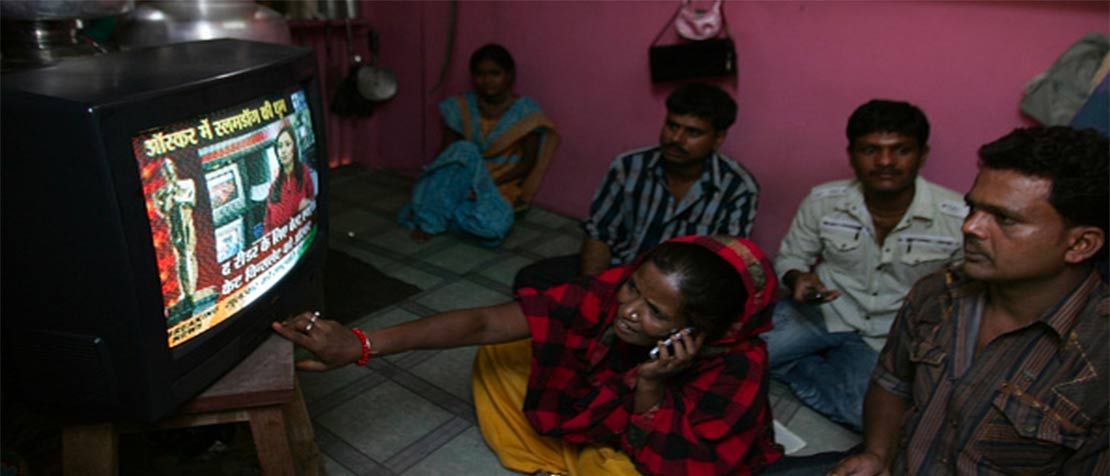
How can television-viewing help to advance the SDGs ?
When somebody thinks about how the global community might achieve the Sustainable Development Goals (SDGs), it is unlikely their next thought would be about watching television – but it might be a good idea.
Everyone agrees that if the world is to build peaceful societies, eradicate poverty, and successfully address climate change by 2030, implementation of the SDGs must start moving at a faster pace. Clearly, as a communications technology, television is a powerful medium for imparting information to the public — news, current events and diverse opinions can all be broadcast cost-efficiently to enormous audiences.
TV is also an excellent medium for entertainment. The average American watches over 5 hours of TV each day, and in many others region of the world the average person watches at least 2 hours of TV per day. Much of this time is spent fulfilling the age-old human demand for entertainment.
But what if you could simultaneously entertain and educate audiences using the broadcast power of TV?
That is just what Miguel Sabido, then Vice President for Research at Televisa in Mexico, did in the 1970s. Sabido developed a new pro-social communication model using telenovelas to promote literacy, family planning, and other social development goals.
For example, Acompáñame, a Sabido produced telenovela which aired in 1977 and 1978, used engaging and entertaining characters to role-model spousal harmony when couples made family planning decisions. The results of Sabido’s theory-driven entertainment were impressive:
- Phone calls to the Mexican government’s national population council (CONAPO) requesting family planning information increased from zero to an average of 500 a month. Many people calling mentioned that they were encouraged to do so by the Acompáñame.
- More than 2,000 women registered as voluntary workers in the national program of family planning. This was an idea suggested in Acompáñame.
- More than 560,000 women enrolled in family planning clinics, an increase of 33 percent (compared to a 1 percent decrease the previous year).
Today, Sabido’s insights into optimizing the pro-social power of TV live on in new forms.
For example, Population Media Center (PMC), an entertainment organization that changes lives, has substantially extended and built upon the story-telling approach formulated by Sabido – in over 50 countries so far.
PMC creates socially relevant dramas whose fictional settings and characters accurately reflect the existing world of the audiences.
PMC then combines great episodic stories – with captivating characters, cliffhangers, multiple/interwoven storylines, and unexpected plot twists – with time-tested social and communication theories. Bandura’s Social Learning and Social Cognitive Theories play a central role. According to these theories, much of human behavior is learned through observation of role models, whether in person or through the media.
Watch the video below to learn more about PMCs television and radio programming:
Since its founding in 1998, PMC has continued to prove the pro-social power of TV – and radio in some countries, where it remains the dominant medium.
For example, PMC co-produced Último Año (“Last Year”) with MTV Latin America in 2012 and 2013. The 70-episode TV serial drama reached 22 million households across the region. Within the first month of broadcast, Último Año’s website recorded 324,000 visits and 1.4 million page views. Último Año went on to win a number of MTV awards, including TV production, musical theme, best finish, favorite antagonistic character, and best performance.
More recently, PMC produced East Los High in association with Wise Entertainment as a Hulu original series for hulu.com – a popular internet TV platform in the United States. East Los High rose to be one of the top five shows on hulu.com during its first season and eventually received five Emmy nominations.
During the first month of airing, more than 27,000 people accessed a family planning widget directly from the eastloshigh.com website. Consistently tackling issues like adolescent reproductive health, family planning, domestic violence, and HIV/AIDS, the show was both hugely popular and socially influential from 2013 to 2017.
As the global community works hard to achieve the SDGs, reformers would do well to keep in mind that television is a powerful tool for good – when deployed properly, TV’s ability raise public awareness about the agenda of the United Nations remains unparalleled.
And beyond awareness, the power of theory-driven entertainment – like Population Media Center’s programs — can encourage audiences to rapidly implement social change in support of the SDGs and other worthy objectives.

© Featured Photo by Vijayanand Gupta/Hindustan Times via Getty Images
